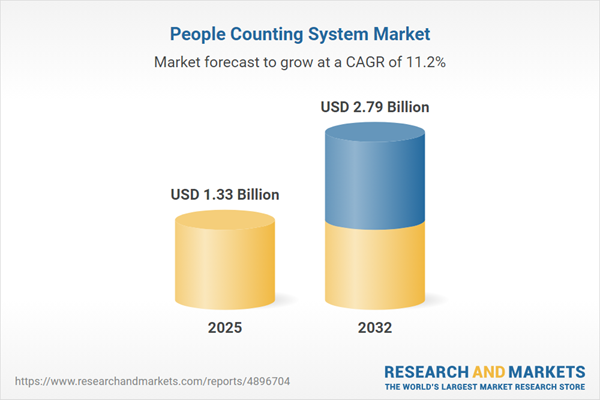Speak directly to the analyst to clarify any post sales queries you may have.
The people counting system market is evolving quickly, enabling organizations to strengthen occupancy analytics and sharpen operational efficiency as compliance demands grow. Senior decision-makers gain access to powerful tools for resource management, security, and regulatory alignment, helping to drive smarter, data-backed decisions in a complex business climate.
Market Snapshot: People Counting System Market Growth and Dynamics
The people counting system market is experiencing significant expansion, with a projected increase from USD 1.19 billion in 2024 to USD 1.33 billion in 2025, escalating to USD 2.79 billion by 2032 at a CAGR of 11.19%. This trajectory is propelled by organizations' need for advanced occupancy analytics and more effective resource allocation. As requirements for compliance intensify, market providers are investing in integrated solutions that go beyond simple foot traffic measurement, adapting to new regulations and supply chain adjustments. Providers' shift toward delivering actionable intelligence highlights the rising importance of intelligent systems for addressing both operational and compliance demands.
Scope & Segmentation: Technologies, End Users, and Market Reach
This report systematically analyzes the people counting system market by technologies, applications, regions, end-user verticals, and company strategies, illuminating the pathways for industry adoption and value generation:
- Hardware Components: Range from camera-based counters, infrared sensors, laser solutions, pressure mat counters, to thermal detectors—all geared toward precise, reliable occupancy data collection.
- Software Solutions and Services: Include versatile analytics platforms and professional consulting to extract insights and support custom compliance needs.
- Technology Categories: Address specific use cases through camera-based sensing, laser, infrared, pressure mat, and thermal modalities, allowing tailored deployments for retail, hospitality, healthcare, and compliance-sensitive sectors.
- End Users: Incorporate enterprises from corporate offices, educational facilities, healthcare providers, and transit hubs to retailers and hospitality operators, each optimizing safety, planning, and operational transparency.
- Applications: Encompass footfall analytics, queue management, facility optimization, and security monitoring, supporting strategic planning and adherence to compliance mandates.
- Geographic Coverage: Examines trends across the Americas, Europe, Middle East & Africa, and Asia-Pacific, with special focus on innovation and leadership in the United States, Canada, China, India, Germany, United Kingdom, Brazil, and Australia.
- Company Strategy Analysis: Reviews the positioning and technological investments of major providers such as Axiomatic Technology Ltd., Sensormatic Electronics Corp., SenSource, and Axis Communications AB.
Key Takeaways for Decision-makers
- Sensor fusion and artificial intelligence are driving greater accuracy and responsiveness in real-time occupancy analytics, supporting advanced operational planning and improved occupant experiences.
- Flexible system architectures offer easy reconfiguration, enabling organizations to adapt swiftly to changing business objectives and regulatory shifts.
- Heightened attention to privacy and data security is influencing adoption of non-intrusive sensors and edge analytics, minimizing exposure risks while maintaining data integrity.
- Regional market factors shape adoption: For instance, North American businesses focus on enhanced analytics in smart facilities, EMEA organizations underline non-invasive compliance, and Asia-Pacific markets benefit from infrastructure and urban development.
- Partnerships foster growth, as collaborations with edge computing and specialty software providers enable enhanced scalability and adaptability across sectors and market sizes.
Tariff Impact on Hardware Supply Chains
New tariffs on critical components, such as cameras and sensors, are increasing costs for people counting system manufacturers and distributors. Companies are turning to nearshoring and regional supplier networks to strengthen supply chain resilience. By adopting modular hardware designs, system integrators reduce risk and preserve performance despite ongoing changes in global trade policies. These adaptive approaches are supporting continuity and market competitiveness in a shifting regulatory environment.
Methodology & Data Sources
This report uses a mix of primary and secondary research sources, including executive interviews, integrator and user feedback, regulatory analyses, and vetted market datasets. Industry peer reviews and triangulation establish the validity and actionability of findings relevant to current industry challenges.
Why This Report Matters
- Clarifies the technology landscape and compliance hurdles in people counting solutions across sectors such as retail, healthcare, and transportation.
- Enables executives to benchmark strategies, evaluate competitors, and make targeted investments based on credible industry analysis.
- Guides procurement decisions, system integration, and risk-management strategies in light of evolving trade and regulatory pressures.
Conclusion
This report gives senior leaders strategic insight on people counting system market adoption. By focusing on modularity, privacy, and compliance, organizations can drive operational agility and value as the market continues to transform.
Additional Product Information:
- Purchase of this report includes 1 year online access with quarterly updates.
- This report can be updated on request. Please contact our Customer Experience team using the Ask a Question widget on our website.
Table of Contents
3. Executive Summary
4. Market Overview
7. Cumulative Impact of Artificial Intelligence 2025
List of Figures
Samples

LOADING...
Companies Mentioned
The key companies profiled in this People Counting System market report include:- Axiomatic Technology Ltd.
- Axis Communications AB
- Dor Technologies GmbH
- Hangzhou Hikvision Digital Technology Co., Ltd.
- Sensormatic Electronics Corp. by Johnson Controls International PLC
- SenSource, Inc.
- Trafsys Analytics Pte. Ltd.
- V-Count UK LTD
- VIVOTEK Inc.
- Xovis AG
Table Information
| Report Attribute | Details |
|---|---|
| No. of Pages | 187 |
| Published | October 2025 |
| Forecast Period | 2025 - 2032 |
| Estimated Market Value ( USD | $ 1.33 Billion |
| Forecasted Market Value ( USD | $ 2.79 Billion |
| Compound Annual Growth Rate | 11.1% |
| Regions Covered | Global |
| No. of Companies Mentioned | 11 |









